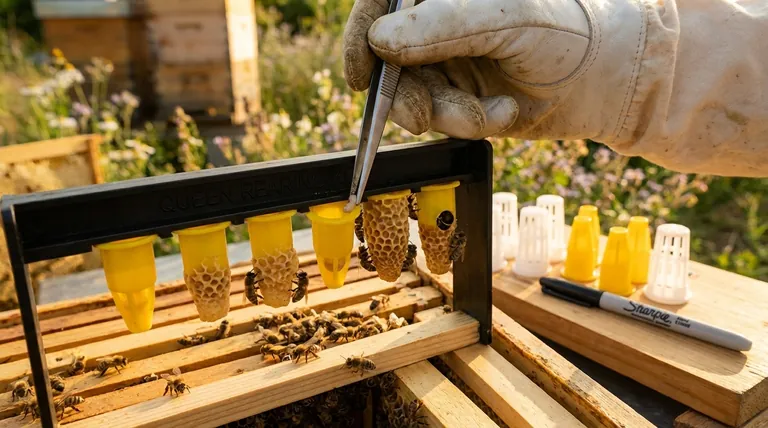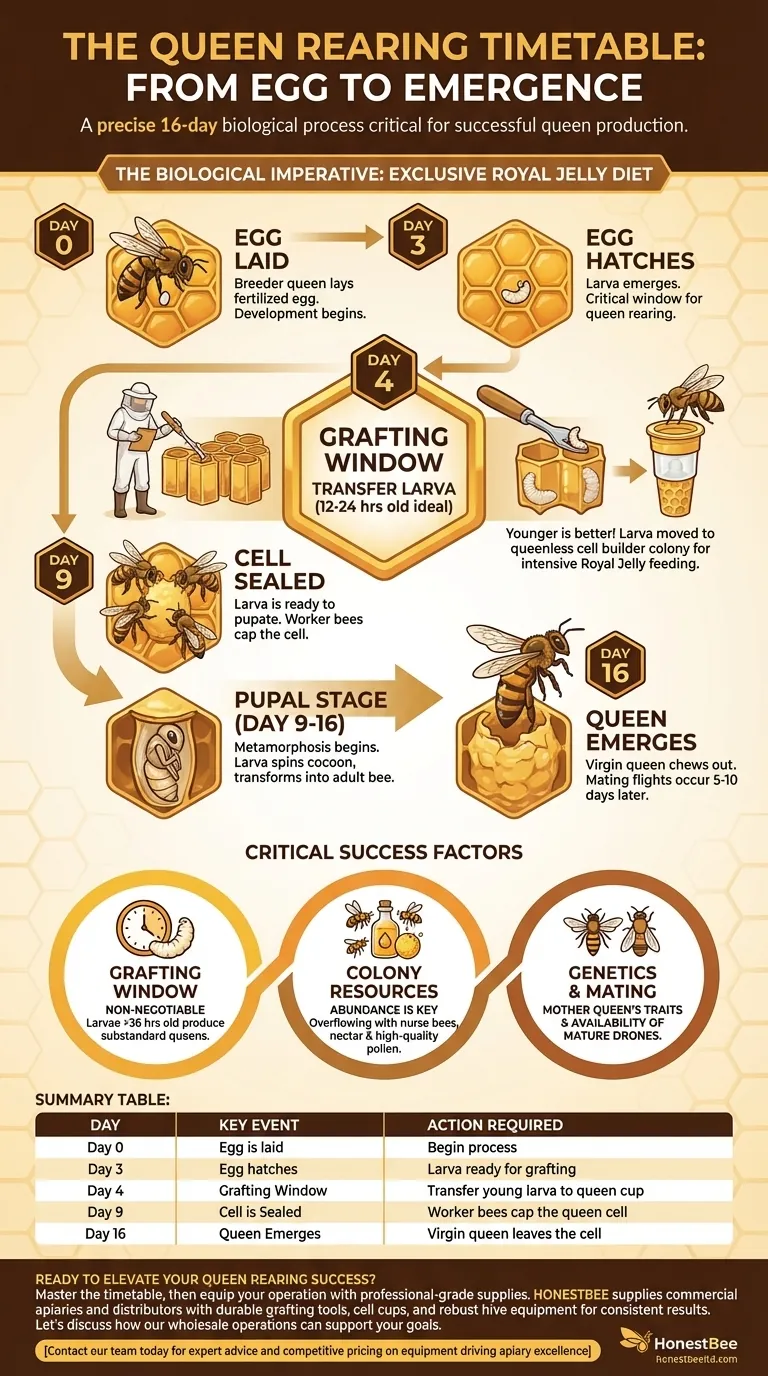From egg to emergence, the queen rearing timetable is a precise, 16-day biological process. Success hinges on specific actions taken at critical developmental milestones. The process begins when an egg is laid (Day 0), it hatches into a larva (Day 3), the larva is transferred or "grafted" into a queen cell cup (Day 4), the cell is sealed by worker bees (Day 9), and the virgin queen emerges from her cell (Day 16).
The fixed nature of the queen rearing calendar is not a beekeeping convention, but a biological imperative. The entire process is designed to ensure a chosen larva is fed an exclusive diet of royal jelly from its earliest moments, which is the sole trigger that develops it into a queen instead of a worker.

The Developmental Blueprint: A Day-by-Day Breakdown
Understanding the queen rearing calendar is about understanding the bee's life cycle. Each stage is a prerequisite for the next, and the timing is determined by biology, not the beekeeper's convenience.
The Egg Stage: Day 0 to Day 3
The process begins when a breeder queen lays a fertilized egg. For three days, this egg develops, remaining unchanged in appearance until it hatches. This is your initial waiting period.
The Larval Stage: Day 3 to Day 9
On Day 3, the egg hatches into a tiny larva. This marks the most critical window for queen rearing. The larva must be fed a continuous diet of royal jelly to develop into a queen.
On Day 4, you perform the graft. This is the physical act of transferring a very young larva (ideally 12-24 hours old) from its original worker cell into a man-made queen cup. This cup is then placed in a powerful, queenless "cell builder" colony, whose nurse bees will immediately begin feeding the larva copious amounts of royal jelly.
The Pupal Stage: Day 9 to Day 16
By Day 9, the larva has grown dramatically and is ready to pupate. The worker bees will cap the queen cell with wax, sealing the developing queen inside. She will then spin a cocoon and metamorphose from a larva into an adult bee.
On Day 16, the fully formed virgin queen chews her way out of the cell and emerges. From this point, she will need several more days to mature before embarking on her mating flights.
Understanding the Critical Success Factors
A calendar is just a map; successful arrival depends on having the right vehicle and fuel. Simply following the dates is not enough to guarantee a high-quality queen.
The Non-Negotiable Grafting Window
The most common point of failure is grafting larvae that are too old. A larva older than 36 hours has likely been fed a "worker" diet for a period, which impairs its full development as a queen. This results in smaller, less robust queens with lower egg-laying capacity. The younger the larva at grafting, the better the queen.
Essential Colony Resources
A cell-builder colony cannot create quality queens without overwhelming resources. It must be overflowing with young nurse bees to produce royal jelly, and have an ample supply of incoming nectar and high-quality pollen. A weak or starving colony will cut corners, creating substandard queens or abandoning the cells altogether.
Genetics and Mating Conditions
The calendar only gets you a virgin queen. Her ultimate value depends on two final factors. First is her genetics, inherited from the mother queen you selected for desirable traits like gentleness, disease resistance, and productivity. Second is the availability of mature drones and suitable weather for her mating flights, which occur roughly 5-10 days after she emerges.
Making the Right Choice for Your Goal
Use this calendar not as a rigid script, but as a framework for planning. Your primary objective will determine where you focus your energy.
- If your primary focus is timing your first attempt: Work backward from your target emergence date (Day 16) to determine your grafting day (Day 4) and ensure your cell-builder colony is ready.
- If your primary focus is maximizing queen quality: Concentrate on grafting the youngest larvae possible (less than 24 hours old) and providing the cell-builder colony with an abundance of bees, pollen, and nectar.
- If your primary focus is long-term apiary improvement: Remember that the calendar is just one tool; your most important decision is selecting the right mother queen to propagate the genetic traits you value most.
Mastering this biological timetable gives you the power to actively guide the genetic destiny of your apiary.
Summary Table:
| Day | Key Event | Action Required |
|---|---|---|
| Day 0 | Egg is laid | Begin process |
| Day 3 | Egg hatches into larva | Larva is ready for grafting |
| Day 4 | Grafting Window | Transfer young larva to queen cup |
| Day 9 | Cell is Sealed | Worker bees cap the queen cell |
| Day 16 | Queen Emerges | Virgin queen leaves the cell |
Ready to Elevate Your Queen Rearing Success?
Mastering the timetable is the first step. Equipping your operation with the right tools is what ensures consistent, high-quality results.
HONESTBEE supplies commercial apiaries and beekeeping equipment distributors with the professional-grade supplies needed for successful queen production. From durable grafting tools and cell cups to robust hive equipment that supports strong cell-builder colonies, we provide the reliable foundation your business depends on.
Let's discuss how our wholesale-focused operations can support your queen rearing goals. Contact our team today for expert advice and competitive pricing on the equipment that drives apiary excellence.
Visual Guide

Related Products
- Jenter Queen Rearing Kit Complete Set for Bee Breeding
- Nicot Queen Rearing Kit for Beekeeping and Grafting in Nicot System
- No Grafting Queen Rearing Kit: System for Royal Jelly Production and Queen Rearing
- Brown Nicot Queen Cell Cups for Breeding Queen Bees Beekeeping
- Durable Galvanized Steel Spring Queen Bee Cage
People Also Ask
- What is the timeline for queen breeding? A 28-Day Guide from Egg to Laying Queen
- How can beekeepers start a honey bee breeding program? Build a Superior, Resilient Apiary
- Why is raising queens beneficial for beekeepers? Gain Control Over Genetics and Costs
- What is queen rearing in beekeeping? Take Control of Your Apiary's Genetics
- What were the size differences among queens reared from worker larvae? Maternal Origin Determines Queen Size



















